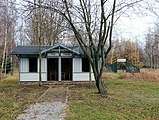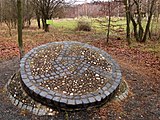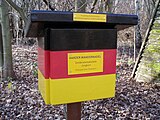Jungborn health resort
The sanatorium Jungborn was a sanatorium , which in 1896 in the Valley of Ecker at Stapelburg was founded. It is considered Germany's first and largest naturopathic institute . The facility was used for cures until the Second World War and was subsequently used for similar purposes. Because of its proximity to the inner-German border , the facility on the territory of the GDR was completely removed in the early 1960s for border security reasons .
description
The Kuranstalt Jungborn was 250 meters above sea level on the northeast side and thus the leeward side of the Harz with less precipitation . The area in the valley was protected from the wind by trees. It was initially around 10 hectares and later expanded to 40 hectares. There were numerous buildings on it, including air huts, light air houses, dining rooms as well as administration and supply buildings. The around 100 light air houses made of wood served as accommodation for spa guests. They had one or two rooms and had large windows and louvers.
The health resort included a nursery with greenhouses, farmland and orchards, the products of which were used in the health resort. Initially, it was possible to accommodate around 250 spa guests. The heyday of the spa facility was the 1920s, towards the end of which it became a district of Stapelburg. With the erection of permanent buildings and the installation of heating and hot water from 1924, the spa operation was extended to the whole year. Between 500 and 1000 spa guests came in summer. In 1930 the sanatorium was expanded by leasing the Villa Waidmannsruh and purchasing the neighboring Föhrenhaus.
The sanatorium was divided into the Friedrichspark, the women's air park and the men's air park. Morning calisthenics with singing and playing took place in the park areas. The women’s and men’s park was separated by a two meter high wooden wall, as many spa treatments took place in naturism . There were also other smaller parks.
Cures
The Kuranstalt Jungborn was a medically supervised sanatorium for simple, natural healing procedures under the motto of the founder Adolf Just “return to nature”. The aim of the cures was to offer exhausted and sick people a simple, natural life with peace and reflection. Water, earth, light and air were used as natural remedies. The cures were based on a “planned sick diet only with berries, raw fruit, nuts, whole grain bread, raw sweet and sour milk and milk products” with no meat. There was therapeutic gymnastics with breathing, loosening and relaxation exercises as well as a special, thorough massage. In the early years, the short term lasted from January 15th to October 15th, later it was year-round due to permanent buildings. The spa guests stayed between three and six weeks, depending on the illness. Emanuel Felke , known as the clay pastor , was a guest at the spa and based on this model, he founded his own spa facility in Bad Sobernheim .
Prominent spa guests came to rest and relax, using the seclusion of the spa facility. These included actors such as Marika Rökk , Viktor de Kowa and Hans Albers as well as the singer Leo Slezak . The writer Franz Kafka is said to have overcome a writing crisis during a spa stay in 1912.
history
founding
The founder of the Kuranstalt Jungborn was the trained bookseller Adolf Just , who worked in the Braunschweig bookstore Graff from 1882 . When he fell ill with a nervous disorder a few years later and conventional medical treatment methods failed, he turned to naturopathic treatments, including Kneipp cures . Through self-study he became a lay doctor and recommended loess earth as a remedy.
In 1895, Adolf Just bought the Eckerkrug guest house with 14 acres of meadow outside of Stapelburg an der Ecker . Thereupon he built the Jungborn sanatorium, the groundbreaking of which took place on April 1, 1896 and which opened on June 20, 1896. The name "Jungborn" is based on the mythological term fountain of youth . From 1908 Rudolf Just, the brother of the founder Adolf Just, ran the health resort and expanded it further. During this time it was called Jungborn. Rudolf Just's sanatorium .
The End
After almost 50 years of spa operation, the sanatorium was converted into a children's deportation camp in 1943 and a hospital in 1944 during the Second World War . After the war the sanatorium was confiscated and served from 1945 to 1953 as a lung sanatorium for tuberculosis sufferers within the Soviet occupation zone . In 1952 the sanatorium was cleared and it was vacant for several years. After a renovation, the facility continued to be used as the GDR's state retirement home from 1960 to 1962 . Due to the proximity to the inner German border , which was the Ecker flowing along the property, all buildings were demolished as part of the border security in 1964 because they were in the restricted zone.
today
After the fall of the Wall in 1990, the border installations in the Stapelburg area were removed. Since then, the grounds of the former Jungborn sanatorium have been open to the public. Today it lies on the state border between Lower Saxony and Saxony-Anhalt in the area of the Green Belt . In the course of time the area overgrown. In 2006 an educational institution carried out a research project on the history of the health resort. Since then, the Jungborn Harz Association has kept the area free from vegetation and looked after it. Today it is a large meadow with sparse trees.
In 2007 there was a 111th anniversary celebration on the premises and a 1: 100 scale model of the spa was created based on old photos and drawings. In 2008, a replica of a light air house was built on the site.
The Harzer Grenzweg leads past the area, for which there is a special postmark for the Harzer Wanderadel .
Special postmark "Jungborn" of the Harz hiking pin
literature
- Stapelburger Grenzgeschichten and the Eckertal. Pp. 211–213 ( online (pdf))
- Adolf Just: The Jungborn table. New vegetarian cookbook. Stapelburg, 1910 ( online )
Web links
- Website of the Friends of the Jungborn Harz
- Description of the Kuranstalt Jungborn
- History of the Kuranstalt Jungborn
- Jungborn: Light, Air and Bare Skin from October 16, 2016
- Jungborn: Naked wellness in the imperial era at ndr.de on June 10, 2018
Individual evidence
- ↑ location
- ↑ The plant
- ↑ The Jungborn
- ↑ Idea and concept
- ^ Jungborn at the healing earth company Luvos Just GmbH & Co. KG
- ↑ Spa guests in Jungborn
- ↑ Stefan Klein: How Franz Kafka overcame his writing crisis on the northern edge of the Harz , newspaper article from December 6, 2003.
- ↑ Reiner Stach : Kafka. The years of decisions. S. Fischer-Verlag, Frankfurt am Main 2002, ISBN 3-596-16187-8 , pp. 83-91, chapter Jungborn, Endstation .
- ^ Adolf Just
- ↑ Rudolf Just
Coordinates: 51 ° 53 ′ 11.5 " N , 10 ° 38 ′ 53.5" E






